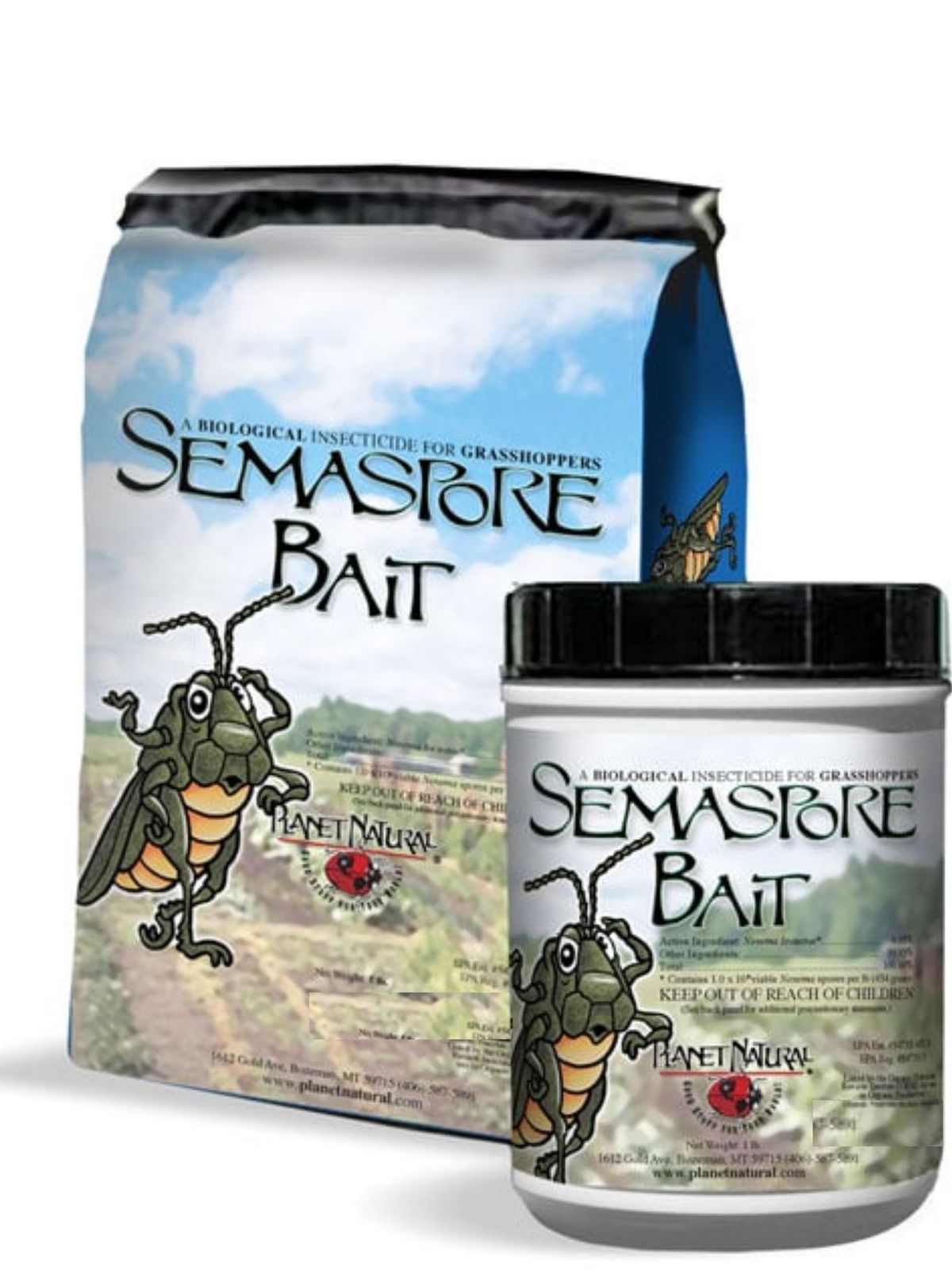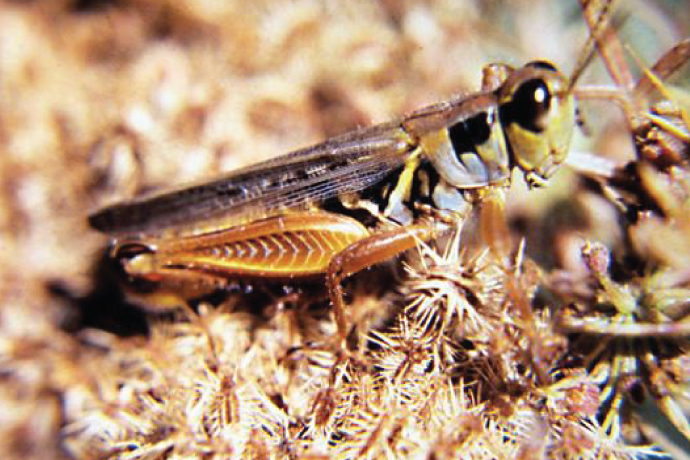Insecticide For Grasshoppers
Large numbers of immature grasshoppers have been spotted in Utah this spring. The best time to control grasshoppers is when they are young, before they have wings and can fly away from insecticide treatments. For best results, organize your neighborhood or local farming/ranching community to work together to treat larger tracts of land. Treating wide areas is a key to success.
In the late summer and fall, adult female grasshoppers lay their eggs in pods in undisturbed soil such as open fields, roadsides, weedy areas, rangelands and boundaries between open space and residential lots. The eggs hatch the following spring and immature grasshoppers, called nymphs, crawl and hop to find green plants to eat. As temperatures warm, soil moisture declines and unmanaged plants dry out. Grasshopper nymphs then move into home yards, gardens and agricultural fields to seek green forage. The best time to treat them is in the early summer as nymphs move from open to cultivated land and before they develop into winged adults. Consider this information for control:
There are three types of insecticide formulations to treat grasshoppers: baits, dusts and sprays.
-
- Baits:
Baits are a mixture of an attractive food source, such as wheat bran, with an insecticide. Common baits contain carbaryl, a carbamate insecticide, or spores of Nosema locustae, a natural grasshopper pathogen. Baits should be spread evenly throughout the habitat and must be reapplied weekly and immediately after rain or irrigation. Baits are selective in that they only kill grasshoppers and other foraging insects (N. locustae will only kill grasshoppers). - Dusts:
Dusts have short residuals and must be reapplied weekly and after rain or irrigation. Both baits and dusts are easy to apply, but moderately expensive. There are numerous insecticide sprays that work against grasshoppers, including malathion, carbaryl, permethrin and bifenthrin. An insect growth regulator, diflubenzuron (Dimilin), is available for commercial-scale applications. - Sprays:
Sprays are less expensive than baits and dusts, but require a sprayer suitable to the scale of application. Sprays will kill on contact or when grasshoppers eat the treated foliage. Check all product labels for allowed application sites. For example, some insecticides can be applied to ornamental but not edible plants.
- Baits:
- For urban sites, apply insecticides along the borders of residential properties and into the open and irrigated lands on either side of the border. There isn’t a threshold established for urban lands, but USDA recommends that treatments begin when nine or more grasshoppers are found per square yard on rangelands. A threshold for cultivated lands, including urban and agricultural, would likely be lower. If possible, apply a border treatment to all neighboring properties along their interface with open lands. For best results, work with neighbors to increase the size of the treated area.
- Another option for sensitive edible plants such as vegetables and herbs is to cover them with floating row cover, a lightweight plant fabric, to exclude grasshopper feeding. Covers on vegetables such as squash that require insect pollination, must be opened during the morning hours when pollinators are most active to ensure good fruit set.
- For grasshopper and Mormon cricket-infested agricultural lands and private rangelands, the Utah Department of Agriculture and Food and USDA Animal and Plant Health Inspection Service have sponsored a cost-share program. Contact your local USU county Extension agent to find out about cost-sharing in your area. For more information on community-wide grasshopper control, see the USU Extension fact sheet here.
Direct column topics to: Julene Reese, Utah State University Extension writer, Logan, Utah, 84322-4900; 435-797-0810; [email protected].
By: Diane Alston, Utah State University Extension entomologist, 435-797-2516, [email protected]
Insecticide For Grasshoppers
Grasshoppers are a problem for farmers and gardeners, but the good news is that there’s an insecticide for grasshoppers. Grasshoppers can be dangerous to your garden, but there’s a solution.
The best insecticide for grasshoppers is one that’s safe to use around people and animals. This means that it should be easy to wash off your skin or hair if you touch it, and it shouldn’t cause any respiratory problems if you breathe in the vapor or dust from the spray.
There are many different kinds of grasshopper-killing pesticides available on the market today. Some of them are made from natural ingredients like pyrethrum, while others are made from synthetic chemicals such as permethrin. You’ll also see some products with multiple modes of action—this means they can kill both adult grasshoppers as well as their eggs at once!
List Of Insecticide For Grasshoppers
- DIVERS INSECT CONTROL – One of the broadest ranges of pest control insecticides ever developed.
- QUICK KNOCKDOWN – can be used at first glance of a pest, preventing problems from materializing.
- PLANT SAFE – Can be applied to herbaceous and woody plants. Roses, flower bushes evergreen plants.
- EASY APPLICATION – Formulated to bloom in the spray tank and provide, superior spray and delivery.
- SIMPLY WORKS – No resistance problems for any of the ornamental, tree and turf pests
Additional Info :
- OUTDOOR USE: Protects lawns, vegetables, fruit and nut trees, roses, flowers, trees and shrubs
- KILLS 260+ INSECTS BY CONTACT: Kills above and below ground – kills grubs, ants as listed, fleas, deer ticks, Japanese beetles, European crane flies and other listed insects
- NON-STAINING: Non-staining to most home siding depending on age and cleanliness – see product label for details
- CONCENTRATE FORMULA: Ready-to-spray QuickFlip spray concentrate that attaches directly to your garden hose
Additional Info :
| Color | Multi |
| Item Dimensions | |
| Height | 12 Inches |
| Width | 3 Inches |
| Length | 6 Inches |
| Weight | 2.3809924296 Pounds |
- Fast acting and odorless – Monterey insect Killer is a bacterial product produced by fermentation which rapidly treats plants and does not produce odors.
- Controls many insects – the insect treatment Spray controls caterpillars, leafminers, codling moth, tent caterpillars, gypsy moth, trips, borers, fire ants, and more.
- Variety of uses – this pest control can be used on outdoor ornamentals, lawns, vegetables, and also broadleaf weeds.
- Easy spray application – this CSI alternative product may be applied with a trigger sprayer, hand-held, backpack, or hose-end Sprayers. Carefully read the label directions before use for optimal application.
- Organic gardening – the active ingredient in our bug Killer spray is a natural bacteria called spinosad, which is the newest agricultural chemistry to be introduced. Approved For organic gardening, our product is safe for use around people and pets.
Additional Info :
| Color | 16 oz. |
| Item Dimensions | |
| Height | 6.75 Inches |
| Width | 3.5 Inches |
| Length | 6.75 Inches |
- Kills over 500 listed pests on vegetables, fruits, ornamentals, lawns and around the home perimeter
- Formulated to protect over 250 vegetables and fruits
- Can be used up to one day of harvesting on tomatoes, peppers, berries, grapes, leafy vegetables and more listed on the label
- Kills common household bugs such as ants, roaches, and spiders outside before they come inside
- Active Ingredients: Zeta-Cypermethrin
Additional Info :
| Color | Brown/A |
| Item Dimensions | |
| Height | 1 Inches |
| Width | 1 Inches |
| Length | 1 Inches |
| Weight | 2.15 Pounds |
- OMRI listed; meets National Organic Program (NOP) requirements
- Can be used throughout the growing season, on many different garden sizes, up to the day of harvest
- Created from botanically-derived pyrethrins, making it the ideal insecticide product for your garden
- Can be used on many different types of plants, including tomatoes, peppers, cucumbers, and celery
- Kills more than 200 types of crop-damaging insects, including beetles, mites, roaches, and ants
Additional Info :
| Item Dimensions | |
| Height | 5 Inches |
| Width | 1.5 Inches |
| Length | 3 Inches |
| Weight | 0.6 Pounds |






